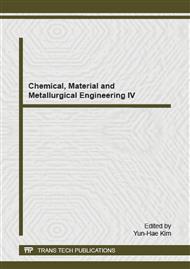[1]
K. Simma, G. L. Rempel and P. Prasassarakich: Polymer Degradation and Stability, Vol. 94(2009), P. (1914).
Google Scholar
[2]
R. Alex and C. Nah: Journal of Applied Polymer Science, Vol. 102(2006), P. 3277.
Google Scholar
[3]
H. Fang and X. Fu: Guangdong Chemical Industry, Vol. 34(2007), P. 26.
Google Scholar
[4]
G. Chen, J. Qin, C. Chen, W. Ning, Z. Chen, J. Lin, F. Li and S. He: Chinese Journal of Tropical Crops, Vol. 30(2009), P. 211.
Google Scholar
[5]
M. Sadat-Shojai and A. Ershad-Langroudi: Journal of Applied Polymer Science, Vol. 112(2009), P. 2535.
Google Scholar
[6]
T. Poli, L. Toniolo and O. Chiantore: Applied Physics A: Materials Science & Processing, Vol. 79(2004), P. 347.
Google Scholar
[7]
L. Toniolo, T. Poli, V. Castelvetro, A. Manariti, O. Chiantore and M. Lazzari: Journal of Cultural Heritage, Vol. 3(2002), P. 309.
DOI: 10.1016/s1296-2074(02)01240-2
Google Scholar
[8]
J. Branquinho, J. A. C. Alves, S. Carvalho, J. Moniz, F. Oliveira and M. H. Gil: Journal of Coatings Technology and Research, Vol. 6(2009), P. 483.
Google Scholar
[9]
D. P. Dowling, C. E. Nwankire, M. Riihimaki, R. Keiski and U. Nylen: Surface & Coatings Technology, Vol. 205(2010), P. 1544.
Google Scholar
[10]
S. W. Kwon, D. H. Yoon, W. S. Yang, H. M. Lee, W. K. Kim, H. Y. Lee and G. S. Son: Journal of the Korean Physical Society, Vol. 55(2009), P. 1808.
Google Scholar
[11]
J. Glodek, P. Milka, I. Krest and M. Keusgen: Sensors and Actuators B-Chemical, Vol. 83(2002), P. 82.
DOI: 10.1016/s0925-4005(01)01048-6
Google Scholar
[12]
F. Zhao, X. Zeng, H. Li and J. Zhang: Colloids and Surfaces A: Physicochemical and Engineering Aspects, Vol. 396(2012), P. 328.
Google Scholar
[13]
F. Zhao, X. Zeng, H. Li and J. Guo: Iranian Polymer Journal, Vol. 22(2013), P. 775.
Google Scholar
[14]
J. Y. Lee, S. O. Jeon and K. S. Yook: Organic Electronics, Vol. 10(2009), P. 1583.
Google Scholar
[15]
N. Jaballah, K. Hriz, M. Majdoub, M. Jouini and J. L. Fave: High Performance Polymers, Vol. 22(2010), P. 483.
DOI: 10.1177/0954008309348664
Google Scholar
[16]
L. Zhang, L. Zang, H. Zhang and J. Guo: Iranian Polymer Journal, Vol. 22(2013), P. 93.
Google Scholar
[17]
L. R. Hutchings, A. P. Narrianen, R. L. Thompson, N. Clarke and L. Ansari: Polymer International, Vol. 57(2008), P. 163.
Google Scholar
[18]
A. Fakhar, M. Razzaghi-Kashani and M. Mehranpour: Iranian Polymer Journal, Vol. 22(2013), P. 53.
Google Scholar


